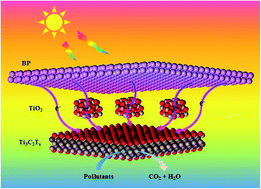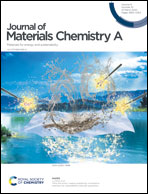Ti3C2Tx MXene decorated black phosphorus nanosheets with improved visible-light photocatalytic activity: experimental and theoretical studies†
Abstract
Metal-free black phosphorus (BP) nanosheets have emerged as a promising photocatalyst. Herein, early transition-metal carbide and nitride (MXene) decorated BP (Ti3C2Tx/TiO2–BP) nanohybrids were constructed by a hydrothermal method, in which TiO2 was produced in the hydrothermal process. The optimized Ti3C2Tx/TiO2–BP nanohybrids exhibited a higher visible-light photodegradation efficiency of rhodamine B (99.09%) and tetracycline hydrochloride (92.70%) pollutants than that of pristine BP (12.75% and 9.35%, respectively). Diverse characterization techniques and density functional theory calculations have revealed that such enhanced photocatalytic performance was due to the synergistic effect of BP and Ti3C2Tx/TiO2, which could markedly improve the stability of BP, increase visible light absorption, prolong the photoexcited electron lifetime, accelerate the photoinduced electron transfer and hinder the electron–hole (e−–h+) pair recombination. Meanwhile, the mechanism analysis indicated that ˙O2− radicals played a leading role in the photocatalytic process. This study will motivate great interest in using 2D MXenes as co-catalysts to enhance the activity of BP for its applications.



 Please wait while we load your content...
Please wait while we load your content...